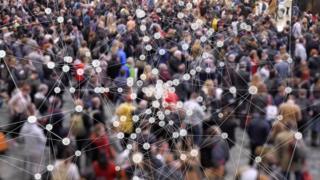Coronavirus R0: Is this the crucial number?
 Image copyright Getty Images
Image copyright Getty ImagesThere is a simple, but crucial number at the heart of understanding the threat posed by the coronavirus. It is guiding governments around the world on the actions they need to take to save lives and it gives us clues to the extent that lockdown can be lifted.
It is called the basic reproduction number or simply the R0 (pronounced R-nought).
What is an R0?
The reproduction number is a way of rating a disease's ability to spread.
It's the number of people that one infected person will pass the virus onto, on average, assuming that nobody is immune and people don't change their behaviour to avoid getting ill.
Measles has one of the highest numbers in town with a reproduction number of 15. It can cause explosive outbreaks.
The new coronavirus, known officially as Sars-CoV-2, has a reproduction number of around 3, but estimates vary.
Why is it important?
If the reproduction number is higher than 1, then the number of cases increases exponentially - it snowballs like debt on an unpaid credit card.
But if the number is lower than 1, then the disease will eventually peter out as not enough new people are being infected to sustain the outbreak.
The goal of governments around the world has been to force the reproduction number down from around 3 to below 1.
This is the reason you've not seen family, have to work from home and the children are off school. The main tool governments have used is to stop people coming into contact with each other to cut the ability of virus to spread.
- A SIMPLE GUIDE: How do I protect myself?
- IMPACT: What the virus does to the body
- RECOVERY: How long does it take?
- LOCKDOWN: How can we lift restrictions?
- ENDGAME: How do we get out of this mess?
What has happened in the UK?
The reproduction number is not fixed for all time, instead it changes as our behaviour changes or as immunity to the virus develops.
Mathematical modellers at Imperial College London are attempting to track how the number has changed as isolation, social distancing and the full lockdown were introduced.
Before any measures were introduced the number was well above 1, the conditions were ripe for a large outbreak. Successive restrictions brought that figure down, but it was not until full lockdown that it was driven below that vital threshold of 1.
It's a bit technical, but by this point scientists refer to the Rt, rather than the R0, as the number is changing over time.
The figure seems to be around 0.7. There is always some uncertainty in this type of work, but there is a high degree of confidence from government's scientific advisors that the figure is below 1 overall.
The situation is different in some hospitals and care homes where the virus is spreading.
So how does this inform lifting lockdown?
As countries think about how to lift lockdown, the aim will be to keep the reproduction number below 1.
"The reproduction number will be an important consideration," Dr Adam Kucharski, from the London School of Hygiene and Tropical Medicine, told the BBC.
"There is risk you very quickly end up back in exponential territory, it's a big challenge making sure you're not loosening too much and increasing transmission."
However, there is an unwelcome fact in the reproduction number.
It has taken a monumental effort, that has caused damage to people's lives, to get the number from 3 to 0.7.
"It doesn't give you a lot of room to play with [to keep it below 1]," Dr Kucharski added.
Earlier in April, Germany managed to get its reproduction number to around 0.7, the same as the UK's now.
Prof Lothar Wieler, president of the country's Robert Koch Institute, said the number had increased to 1.
"The number should stay below one, that is the big goal," he said.
Which measures could be lifted?
Unfortunately there is not a manual that says definitively how much each intervention changes the ability of the virus to spread, although there are estimates.
"Lockdown introduced all these measures at once so we haven't got a really good sense of how much each one contributes to the reduction," said Dr Kucharski.
He added: "Opening schools versus workplaces versus other gatherings - understanding how much they increase the reproduction number is going to be the challenge."
Another issue is people's behaviour changes over time too, which means the number can creep up even if the lockdown policies stay the same.
What is likely to be needed are new ways of controlling the virus, such as more extensive testing and tracing or location-tracking apps.
These can suppress the reproduction number in a more targeted way, allowing some of the other measures to be lifted.
Is it the most important number?
The reproduction number is one of the big three.
Another is severity - if you have a very mild disease that does not cause many problems then you can relax a bit. Coronavirus, and the disease it causes Covid-19, is unfortunately severe and deadly.
The last is the number is the number of cases, which is important for deciding when to act. If you have a high number of cases, but ease restrictions so the reproduction number is around 1 then you will continue to have a high number of cases.
What about a vaccine?
Having a vaccine is another way of bring the reproduction number down.
A coronavirus patient would naturally infect three others on average, but if a vaccine could protect two of them from infection then the reproduction number would fall from 3 to 1.
Follow James on Twitter
Source : BBC News - Science & Environment
Coronavirus R0: Is this the crucial number?
Coronavirus R0: Is this the crucial number?
